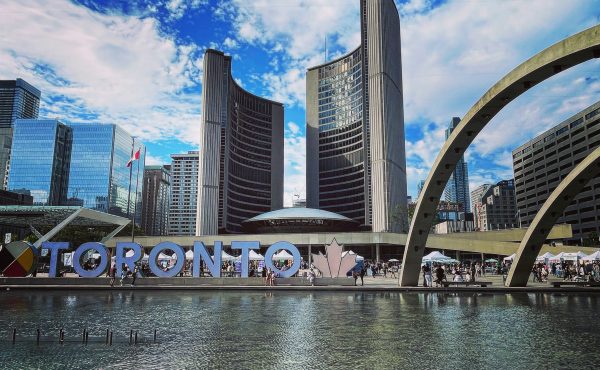

I’ve been trying to comprehend what Mayor David Miller means when he predicts the Liberals’ funding delay means the $4.6 billion Eglinton LRT may only extend “from Leaside to Forest Hill,” and I confess I’ve not had much success.
Yes, there’s the obvious connotation – due to the slow-down imposed by Queen’s Park, only these silver-spoon neighbourhoods will reap the benefits of Transit City Lite, while the great suburban unwashed can just keep on bussin’.
The alternative reality, according to Metrolinx spokesperson Vanessa Thomas, is that the Eglinton LRT tunnel will extend from Brentcliffe Dr. (one east of Laird) to Black Creek Drive (about half a kilometer west of Keele). So either Forest Hill is much larger than the realtors thought or the mayor needs a geography lesson.
Metrolinx also says it’s going to order the tunneling equipment next month, and will be constructing the eastern and western launch sites between 2011 and 2012, with boring to commence thereafter, for a total outlay to 2015 of $1.8 billion.
Aha! the mayor cries. The post-2015 funding isn’t even in the province’s long-term budget. Is he implying the Government of Ontario may ante up to bore a 6.4-km bowling alley under mid-town Toronto and then turn off the spigots before the remaining $2.8 billion is spent?
Yes, says Miller spokesperson Stuart Green, that’s precisely what he’s suggesting. “It’s a pretty huge leap of faith that that money will be guaranteed.”
Sure, one can project the worst-case outcome on any forward-looking scenario. But is the completion of the Eglinton LRT really “a leap of faith”? Please.
Come 2016, Ontario’s economy will be back in full swing, easing pressure on provincial coffers and making those future budget cycles substantially less painful.
Even if Tim Hudak’s Tories regain power, either in 2011 or 2015, will they want to take responsibility for burying all that taxpayer money by cancelling the as-yet unbuilt surface portions? I know, I know: Harris & Co. squandered $100 million on the aborted Eglinton subway back in the day. But my guess is that a party looking to re-assert its fiscal discipline will prefer not to wear that one twice.
Take another regrettable scenario: Rob Ford becomes mayor, and begins agitating for the outright cancellation of Transit City. Now say you’re Dalton McGuinty. Is Mr. Customer Service™ a gift from the gods? Absolutely.
With council in what I assume will be a state of civil war, Metrolinx emerges as a beacon of urban-minded sanity, delivering transit solutions backed by such bastions of glassy-eyed radicalism as the Board of Trade. Ford, the premier will gleefully tell us at every opportunity, is what you get if you vote for Hudak in 2011.
How about gaming out a George Smitherman scenario? The Once and Future Mayor is releasing his transit plan Friday, and it will have the predictable verbiage about taking a hard look at all these projects, blah, blah, blah. But while the tunnel construction proceeds, a Smitherman-run council will have an entire term to figure out how not to reprise St. Clair West/Yorkville/Roncesvalles on the new TC lines.
Much more importantly, the Eglinton LRT passes through the ridings of n fewer than nine of Smitherman’s former caucus colleagues, including three cabinet ministers (Tony Ruprect, Mike Colle, Hon. Eric Hoskins, Hon. Kathleen Wynne, Donna Cansfield, Laura Albanese, David Caplan, Lorenzo Berardinetti, Hon. Brad Duguid). And let’s not kid ourselves: they all want to bring home the transit bacon.
Finally, it’s important to precisely understand Metrolinx’ role in all this. Last week saw the mayor squaring off against CEO Rob Prichard, who has emerged as a political actor in the Transit City melodrama. But this isn’t just about a battle of the alpha males. Quite apart from the policy arguments around regional transit authorities, Metrolinx — with its fancy-schmancy board of directors — functions quite deliberately as an impressive example of elite accommodation.
I don’t want to overstate the board’s influence, but Queen’s Park will think twice before it makes this blue chip crowd look like a bunch of monkeys by cancelling such a huge undertaking mid-stream.
So in the end, the “Leaside to Forest Hill” zinger may have been an appealing –though physically inaccurate — sound-bite. But you don’t have to be a Pollyanna to conclude that Miller’s doomsday prediction about the Eglinton LRT is nothing more than a rhetorical tunnel to nowhere.
photo by Stig Nygaard




6 comments
Metrolinx unofficial Board of Directors portrait:
Hi John,
Your arguments in this article are weak. They amount to “The Eglinton LRT” will get built because I say it will.
Yes, a provincial government may cancel all or any of the LRT at any time… even if the economy is doing well… because you believe that won’t do it is not a reason. Life is not rational or reasonable.
Does building a Sheppard Subway make more sense than Eglinton subway? Does it make sense to blow 100 million dollars on the Eg Subway and not continue the project… which will one day be built in some form and end up being much more expensive in the future? Of course not… but people will rationalize any decision they desire to make.
You want to see my point in action, watch the Republicans in the US and to a lesser degree the Conservative party in Canada. Bob Dole on the John Stewart show
John: How is the underwear bomber different than the shoe bomber?
Bob: The underwear bomber wasn’t an American citizen.
Umnnn…. neither was the shoe bomber… Bob making up his own reality… can’t depend on *anyone* to be rational and logical in politics… or life
I think the Forest Hill to Leaside soundbite is brilliant for a variety of reasons. Although not completely accurate geographically, Miller is drawing a ‘transit as social equality’ argument that is important to the Miller ethos. While the mainstream media (especially Globe) may be uncomfortable with this class-based conversation, I think Miller framing a policy issue in these terms is laudable.
I also think your basic argument that this is a “rhetorical tunnel to nowhere” is somewhat of a straw-man argument. For all your hypothetical situations of different municipal and provincial actors I can think of just another plausible case arguing the funding will be dried up in each scenario.
Even more bizarre is why you would spend so much effort criticizing a Mayor that is just ensuring the province follows through on previous funding commitments for this City. If you don’t care for his strategy or tone, then perhaps Rossi is your man (I assume the Globe’s editorial will go this way). But, is it really necessary to spend time dissecting and chastising a sitting mayor that is trying to get as much upper level transit funding as possible?
The problem with Miller’s “transit as social equity” scheme is twofold:
1) Most of the “priority” areas served by the original four projects (Sheppard East, Finch West, Eglinton, Scarborough RT conversion) will still see improved transit access. Jane and Finch residents (for example) still get the Finch West LRT — it may not get them to Yonge, but it still gets them to the subway (Spadina). A notable exception might be Malvern, given the truncated SRT extension, but Malvern will still be more transit accessible with the Sheppard LRT and the truncated extension (just as, say, Vic Park and Sheppard has better access to Yonge than it did 10 years ago, even though the Sheppard subway only made it to Don Mills). Even if Eglinton never makes it west of Black Creek, it will still result in people shifting their travel patterns and likely an increase in ridership, because of the travel time savings for east-west travel and because of the potential to intercept other trips.
2) Social equity is great, but the projects need to be viewed through at least three other lenses: transportation (these are transportation facilities, after all), construction/phasing, and budgeting (the crux of the current problem). If budget constraints dictate a reduction in the scope of construction, how do you prioritize what’s built and what’s deferred? Presumably this is based on highest transportation need; on that basis it is easy to defer Finch east of the Spadina subway, in that there should be a drop-off in ridership from that point east as riders are intercepted by the Spadina subway. If you prioritize social equity, you could make an argument for building the projects that are less expensive per km (serve longer distances and wider catchment areas for the same money), but this most certainly would mean cutting or deferring Eglinton, the project that is probably the most popular and that likely makes the most sense from a transportation perspective.
One could argue Eglinton should be the place to start, and build the whole thing — defer Sheppard East. Eglinton has the highest transportation need, but it also shows off what LRT can do and will result in the greatest improvements to travel times because of the subway section. Do Eglinton right and you whet the public’s appetite and increase political support for more, even if it requires uncomfortable decisions (esp. funding). I’m not convinced that Finch West or Sheppard East will do that to the same extent.
Maybe I’m a bit slow, but I (still) don’t understand how the current provincial government, by just saying so, can “guarantee” funding in years when they won’t likely be in power.
We live in a country where LRT lines can get funding, but not actual LRTs to run on them. While the federal government doles out cash for various make-work projects, Toronto can’t get cash for long-planned, crucial, but unfunded infrastructure expenditures (that not only WOULD have put people to work immediately, it would have encouraged longer-term confidence needed to get people looking beyond the two years when the stimulus spigots would be open). Why on earth does John L think that the politics favor the TTC, when the evidence is pointing the other way?
A recent article in Toronto Life recommended privatizing the TTC, comparing it to Stockholm’s system. Then the author buries the key fact central to the issue, noting that Stockholm gets twice as much public funding to serve half as many people. The fact that the TTC works at all under such circumstances strikes me as amazing, but the author seems oblivious to the significance of his funding observation, and insists privatization is all we need.
The fact is, the reality of the TTC’s problems has become detached from the politics, and the politics don’t look good for the TTC. John L’s faith that no government would “dare” cut funding after building half of a new transit system seems dangerously naive.